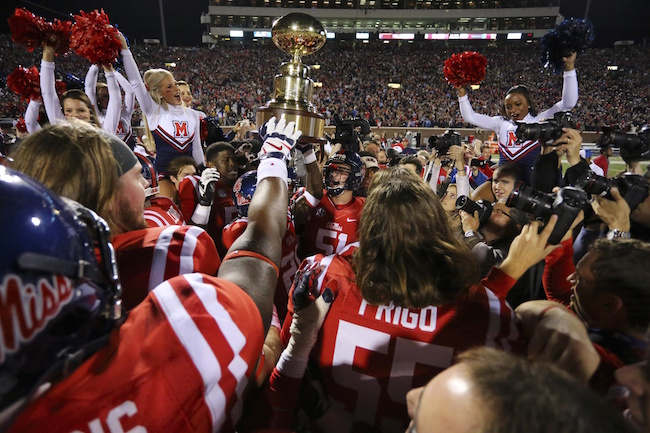Who belongs on Ole Miss' all-time Mount Rushmore?
The more one analyzes Mount Rushmore, the more bizarre it seems.
Imagine visiting the United States from another country, oblivious to American history, and somehow wandering into South Dakota. You look up at granite rock face sprawling above tree line only to see … wait a second, that can’t be a mirage, because this isn’t a desert. That looks like the faces of four stoic men.
For a historic symbol so far removed from Washington D.C. and New York, Mount Rushmore gets a ton of publicity in day-to-day rhetoric. Bill Simmons, formerly of ESPN, popularized it as a sports concept, one that works very well for internet discussions as well as radio bits.
We’ll borrow the subjective exercise. Here is my Ole Miss football version of Mount Rushmore:
WHO’S IN?
John Vaught, Coach
“Head coach” was a transient job in Oxford for decades. Then Vaught took control in 1947. During his 24-year coaching career, he led the Ole Miss football program to national prominence. A former All-American himself at TCU, Vaught produced 26 first-team All-Americans and four players who finished top five in the Heisman Trophy voting.
Poor health forced Vaught to give up his position in 1970, however, the Rebels legend returned mid-season in 1973 as head coach and the university’s athletic director. Vaught resigned as head coach after that season but remained the athletic director for years to come. His final record at Ole Miss was 190-61-12, ranking him among the top 25 winningest coaches in Division I history and fourth among coaches who have spent time in the SEC behind Bear Bryant, Lou Holtz and Vince Dooley.
Under Vaught’s tutelage Ole Miss won three national championships in 1959, 1960 and 1962. The Rebels won the 1959 Dunkel System national title, the 1960 Football Writers Association of America, Dunkel System, and Williamson System national championships and the 1962 Litkenhous Ratings national title.
The place where the Rebels play their home games is called Vaught-Hemingway Stadium for a reason.
Archie Manning, QB
The father of one of the greatest families in all of football also happens to be one of the greatest SEC quarterbacks of all time and a beloved figure in Ole Miss history. The passing records that Manning held when he left Oxford are now mostly held by his son Eli, but when Manning was playing from 1968-70, it was hard to find anyone like him at the position.
The legend of Manning grew even greater after his masterful performance in the first-ever national prime time broadcast of a college football game in 1969. Manning threw for 436 yards (still an Ole Miss single-game record) and three touchdowns, adding 104 rushing yards, in a 33-32 loss to Alabama.
He ended his career in Oxford with 5,576 yards of total offense and 56 touchdowns. His No. 18 jersey was the first ever to be retired at Ole Miss.
Finishing fourth in Heisman balloting in 1969 and third in 1970, Manning went on to be the No. 2 overall pick in the 1971 NFL Draft by the New Orleans Saints.
Eli Manning, QB
From one Manning to the next. (I wonder how similar their massive, stone portraits would look and if they would be hard to tell apart, but I digress.) You name the passing record at Ole Miss and chances are Manning holds it. He set or tied 45 single-game, season and career records while at Oxford.
Some of his most notable Rebels records include his 10,119 career passing yards, 3,600 single-season passing yards, 81 career touchdowns, 60.8 career completion percentage and 10 games with 300 yards or more through the air. Manning also finished third in Heisman voting as a senior.
Manning was the No. 1 overall pick in the 2004 NFL draft by the San Diego Chargers before being traded to the New York Giants. He led the Giants to two Super Bowl championships in 2007 and 2011.
Patrick Willis, LB
Perhaps the most decorated defensive player in Ole Miss history, Willis was a two-time All-American and the recipient of the Butkus and Lombardi awards in 2006.
Willis led the SEC in tackles during his junior and senior seasons with 128 and 137, respectively. As a senior, he was also named SEC Defensive Player of the Year and received the Jack Lambert and Dick Butkus awards, two of the most prestigious honors given to college linebackers.
Selected No. 11 overall in the 2007 NFL draft by the San Francisco 49ers, Willis became a seven-time Pro Bowl selection and lead the league in tackles twice (2007 and 2009).
In a surprising and sudden move, Willis decided to retire from the NFL in March after being sidelined most of 2014 with a toe injury. This was after hand and groin injuries hampered his 2013 season as well.

